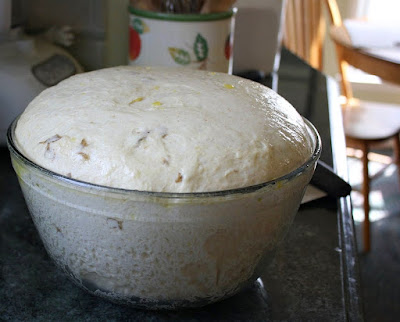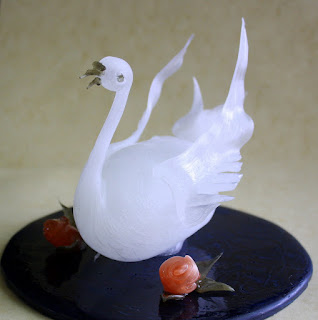Whoa . . . can't quite believe it's been so long since I last posted. I think I've set a Jane's Sweets non-attendance record. Where have I been? Well, I can tell you I wasn't circumnavigating the globe in a sailboat. And I haven't been languishing in suspended animation in a hospital bed. Nor have I been hard at work on a cookbook destined to take the pastry world by storm, and I most certainly have not just had a baby. Nothing as remarkable as all that.
To be perfectly honest with you, I needed a little break. One that did not involve a laser focus on baking fantastic treats. I've been working, you see, on shrinking off a few pounds and it seemed expedient to lay off the homemade delicacies in order to help facilitate that thorny effort. You might say I temporarily pulled my own baking plug. And joined Weight Watchers in the process.
I mean, let's face it . . . I'm essentially a junkie when confronted with high-quality confections, especially those of my own creation. (Yeah, yeah, I know. A stunning revelation. You never could have guessed that, right?) I realized it was truly necessary for me, literally and figuratively, to back away from the dessert cart for a while in order to regroup. At least I can report that, in this semi-unplugged interim, I've made some meaningful shrinkage progress. Nothing dramatic or jarringly obvious, mind you, but all such progress is relative if you inherited chubby genes like mine.
So, anyway, a couple pounds off here, a couple pounds off there, and it all adds up. More exercise, less sugar and butter, way more veggies. It's a happy development. Progress, at this point, is admittedly slower than molasses, but that's okay. I can live with that. Slow and steady wins the race . . . right?
About this recipe . . .
All that said, I just wanted to share this bread with you while it's still fresh, both in my mind and on my kitchen counter. Adapted from a formula in Simply Great Breads, by bread master Daniel Leader (I love this little book), this is a great variation on traditional challah, with a lovely crust and appealing crumb. Wonderful flavor, too. And it's not something that will completely destroy one's diet, if partaken of judiciously.
What did I change? Well, the original recipe included olive oil and, while I do periodically use olive oil in bread, I didn't want it to compete with the other flavors in this loaf so I substituted the more neutral-tasting canola oil. Also, I fiddled with the flours a bit (Leader uses whole wheat flour and all-purpose; I used mostly whole wheat, then a combo of bread flour and all-purpose). I reduced the amount of honey slightly, and I used chopped dried cherries instead of dried apricots, though I think either one would be tasty. And, of course, I reworded the recipe to reflect exactly what I did. This is a very simple loaf to put together, with a pleasingly soft and pliant dough that's not too sticky to work with easily.
The bread is yummy, even unbuttered. I haven't tried it toasted yet but I'm sure it's divine. Maybe a nice, thin, toasted slice tomorrow morning will be called for.
(For a printable version of this recipe, click here!)
Yield: One large braided loaf, or two smaller standard size loaves baked in 9"x5" pans
Ingredients:
2 cups whole wheat flour (about 8.5 oz)
1 cup bread flour
3/4 cup unbleached all-purpose flour
2 and 1/4 teaspoons instant yeast
1 and 1/2 teaspoons fine sea salt or kosher salt
3/4 cup luke warm water
2 large eggs, room temperature and lightly beaten
1/2 cup canola oil
3 tablespoons of honey
1/4 cup of well-chopped dried cherries
For egg wash: 1 large egg, lightly beaten with two teaspoons water (to brush on the unbaked loaf before putting it in the oven)
* * * * *
In the large bowl from your mixer, lightly whisk together the three flours, the yeast, and the salt. Into that, pour the water, eggs, oil, and honey. Using a spatula, stir this up by hand for a few seconds. Now put the bowl back on the mixer and, using the dough hook, mix the dough for about five minutes on the lowest speed, sprinkling in the chopped cherries after about two minutes of mixing. Take the bowl off the mixer and dump the dough out onto a lightly floured work surface. Flour your hands and finish the kneading by hand, for a couple more minutes, until the dough feels soft, smooth, and spongy. It should be tacky but not wet/sticky.
Put the dough into a large, clean bowl that's been oiled/sprayed. Cover it with plastic wrap that's also been oiled/sprayed, and let the dough rise at room temperature for about 90 minutes or up to 2 hours, until it's obviously doubled in size.
On a very lightly floured work surface, dump out the risen dough and deflate it by pressing on it with your palms. Divide the dough into three equal parts (I suggest weighing the dough first; my ball of dough weighed about 35 oz. total, so each of the three dough chunks for the braids weighed a little over 11 oz.). Roll each piece into a rope that's 15 inches long; be assertive and don't worry if the dough tries to shrink back a little as you're doing this.
On a large baking sheet, spread a sheet of parchment paper. Place the three ropes of dough in the middle of the parchment, right next to each other, and pinch the ends together tightly at the top. Proceed to braid the dough snugly (starting from the top with the right braid over the middle braid, then the left one over the center, etc.) until you reach the bottom end; tightly pinch the bottom ends together and tuck the pinched part underneath.
Dust the top of the braided dough with a pinch of flour (the bread flour or all-purpose flour) and cover it with a clean piece of plastic wrap. Let it proof for up to 2 hours, until it looks almost doubled in size. While its proofing, preheat your oven to 350 degrees.
Just before the bread is ready to bake, whisk together the egg and water to make a wash; brush some of the egg wash generously onto the top of the loaf and lightly down the sides.
Bake the bread for up to about 40 minutes, until the internal temperature reaches 200 degrees (use an instant-read thermometer to check if you're not sure), and the color is deeply golden all over. Let the baked bread cool on a rack for a while before slicing.
*If you're baking your bread as two unbraided loaves in standard size (greased) loaf pans, I'd suggest checking them after about 20 minutes in the oven.
(If you'd like to comment on this post, or to read any existing comments, please click on the purple COMMENTS below.)






























































































